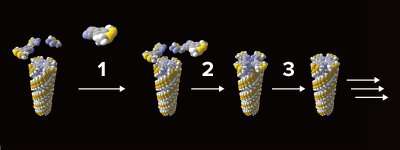Self-templating, solvent-free supramolecular polymer synthesis

A polymer that catalyzes its own formation in an environmentally friendly solvent-free process has been developed by an all-RIKEN team of chemists. The discovery could lead to the development of inherently recyclable polymer materials that are made using a sustainable process.
Polymers are ubiquitous today, but they are detrimental to the environment through the accumulation of plastic waste and the unsustainable nature of conventional polymer manufacture. Polymers are generally made by linking together strings of building blocks, known as monomers, using covalent bonds. But these strong bonds make it difficult to take used, end-of-life plastic items and de-polymerize them to recover the monomers for reuse.
Supramolecular polymers, in contrast, consist of arrays of monomers held together by interactions such as hydrogen bonds, which are weaker, and hence more reversible, than covalent bonds.
However, the solvents used for manufacturing supramolecular polymers limit their application and sustainability. "Within two decades, solvent-free chemical manufacturing may be the only approved chemical processes, since the large volumes of solvent used in other manufacturing processes are too damaging to the environment," says Takuzo Aida from the RIKEN Center for Emergent Matter Science (CEMS).
Aida's team has been investigating wedge-shaped molecules called phthalonitriles. Now, he and nine CEMS colleagues have discovered that these substances melt when heated and then form multiple thin green crystalline fibers, which are rod-shaped supramolecular polymers.
The polymerization process is initiated when four of the wedge-shaped pieces come together to form a flat, circular disk. The disk-shaped assembly—the monomer—can then act as a template surface for the next four wedge-shaped precursor molecules to combine, adding a layer to the structure. This process is repeated, with each new layer of the polymer catalyzing the formation of the next, until long rod-like structures form (Fig. 1). The team named their process solvent-free autocatalytic supramolecular polymerization.
"The mechanical properties of the crystalline fibers of these supramolecular polymers are analogous to those of poly(alkyl methacrylates)," Aida says. These conventional polymers are used for a range of applications, including plexiglass.
The team could create more complex versions of their supramolecular polymers by adding alternate precursor molecules into the mix at certain time points, thereby forming 'block copolymers' with bands of different monomers along the length of each rod.
Solvent-free autocatalytic supramolecular polymerization could be used to make supramolecular polymers from a range of starting materials. "It may be applicable to the synthesis of polycyclic aromatic hydrocarbons and cyclic peptides," Aida says.
More information: Zhen Chen et al, Solvent-free autocatalytic supramolecular polymerization, Nature Materials (2021). DOI: 10.1038/s41563-021-01122-z
Journal information: Nature Materials
Provided by RIKEN




















